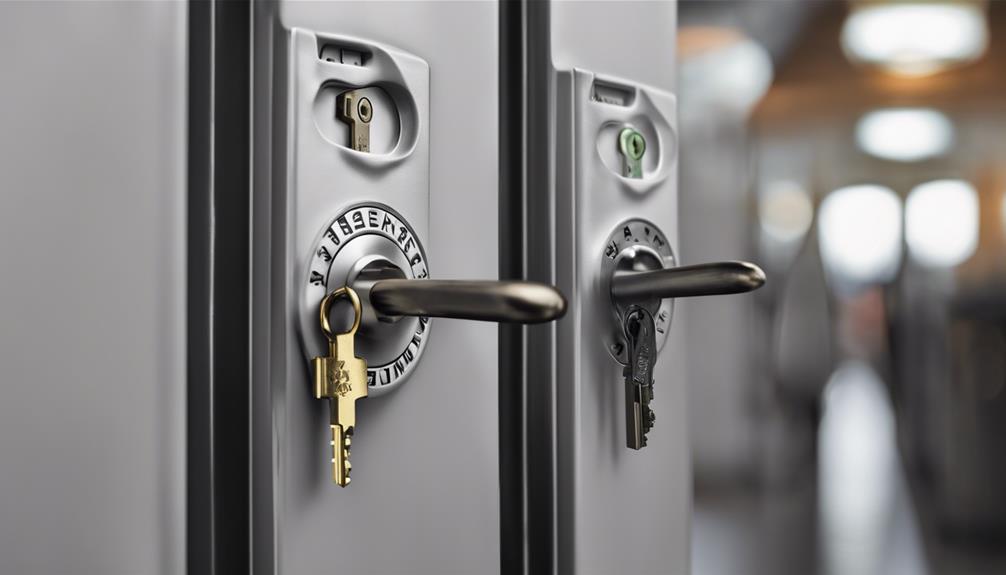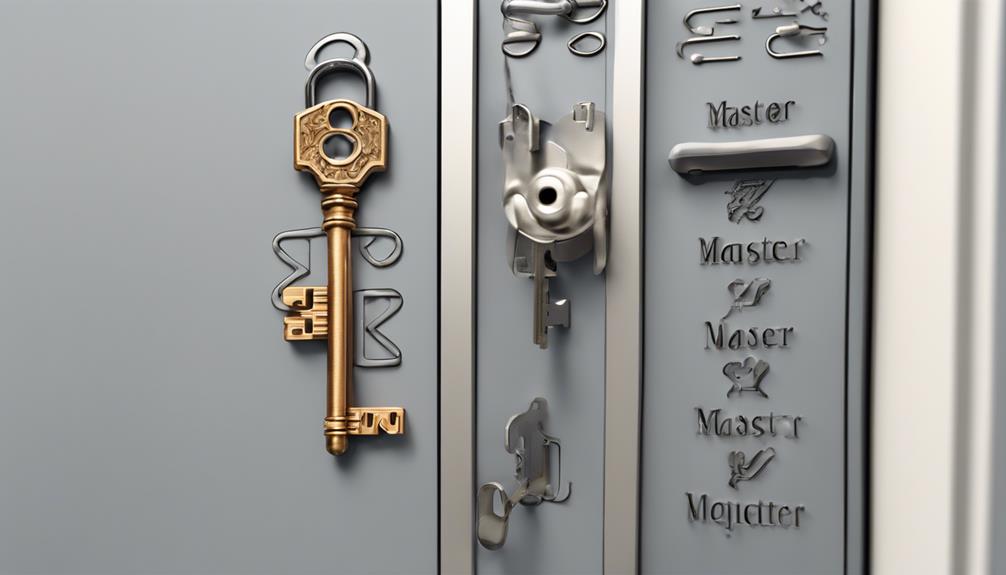When you're considering the security of your business, understanding the difference between a master key and a sub-master key is essential. A master key opens all locks in your system, while a sub-master key has limited access to specific areas. Both keys can be integrated into your access control system, but the implications for security and management are significant. How do these differences impact your overall access strategy? Let's explore the nuances and benefits of each, and how they can work together to enhance your security framework.
Key Takeaways
- Master keys provide access to all locks, while sub-master keys limit access to specific groups or areas within a security system.
- Sub-master keys enhance targeted access in multi-tiered environments, enabling custom access levels for different personnel roles.
- Both master and sub-master keys can be integrated with access control systems for tailored security management and oversight.
- Integration with access control allows for real-time monitoring and automated management of access rights, reducing unauthorized access risks.
- Effective key management solutions support the compatibility and scalability of both master and sub-master key systems in evolving security needs.
Understanding Master Keys

A master key is a powerful tool in access control systems, allowing a single key to open multiple locks. Its history dates back centuries, evolving alongside advancements in lock technology. By understanding the master key's mechanics, you gain insight into security management's strategic advantages. The ability to streamline access for authorized personnel enhances operational efficiency, reducing the time spent managing multiple keys. In addition, integrating sub master keys offers additional benefits, such as compartmentalized access control and enhanced security layers. This tiered approach not only simplifies key management but also fortifies your system against unauthorized entry. By leveraging these sophisticated key systems, you assert control over your environment, ensuring a balance between accessibility and security that meets your organizational needs.
Understanding Sub-Master Keys
A sub-master key is a specialized access tool designed to operate a defined subset of locks within a security system. Its primary purpose is to enhance security while allowing controlled access, making it essential in multi-tiered locking environments. You'll find sub-master keys commonly used in commercial settings, where different levels of access are necessary for various personnel.
Definition and Purpose
Understanding the nuances of sub-master keys is essential for effective access control in various environments. Sub-master keys serve a specific purpose within the access hierarchy, allowing targeted access to designated areas without granting universal entry, as with master keys. They align with organizational needs by offering distinct key types that enhance security levels through controlled access. You must consider lock compatibility to guarantee seamless integration into existing systems. Usage scenarios vary from managing employee access in a corporate setting to securing sensitive areas in healthcare facilities. By implementing sub-master keys, you reinforce key control while enhancing system scalability, ensuring that your access control framework remains robust and adaptable to evolving security demands. Additionally, integrating sub-master keys with an efficient master key system can further optimize access control measures for enhanced security protocols.
Applications in Security Systems
Incorporating sub-master keys into security systems greatly enhances access management. These keys allow you to grant specific access to designated personnel while maintaining control over sensitive areas. By segmenting access, you reduce the risk of unauthorized entry and mitigate security vulnerabilities inherent in traditional key systems.
Sub-master keys also limit the impact of key duplication; if one key is compromised, only a subset of areas remains at risk. This layered approach to security not only strengthens your overall strategy but also guarantees that employees can efficiently perform their duties without overexposure to sensitive zones. Ultimately, integrating sub-master keys into your access control system empowers you to maintain tighter security and better manage access across your organization.
Key Differences Explained

When comparing sub-master keys and master keys, it is crucial to analyze their key functionalities and how they integrate with existing systems. Master keys provide access to all locks in a system, while sub-master keys offer access to a specific group of locks. Understanding these differences will help you make informed decisions regarding access control and enhancing security architecture.
Key Functionality Comparison
Distinguishing between a sub-master key and a master key hinges on their specific functionalities within a locking system. A master key provides broad access, enabling you to gain entry to multiple doors across varying access levels. In contrast, a sub-master key is designed for a specific subset of locks, granting access only to those designated areas. This difference in key compatibility is essential; while a master key can open all locks within a system, a sub-master key limits access, enhancing security. Understanding these functionalities allows you to implement a hierarchical access control strategy, ensuring that individuals only access areas pertinent to their roles, thereby bolstering overall security and operational efficiency in your organization.
Integration With Systems
While both master keys and sub-master keys are integral to secure access control, their integration into broader locking systems reveals key differences in design and application. Master keys typically offer higher key compatibility, allowing access to multiple locks across various areas, while sub-master keys provide targeted access with less flexibility. Understanding these distinctions helps you choose the right system for your needs.
| Feature | Master Key | Sub-Master Key |
|---|---|---|
| Key Compatibility | High | Moderate |
| System Flexibility | Extensive | Limited |
| Access Control Scope | Broad | Specific |
Ultimately, the choice hinges on your organization's security requirements and operational efficiency.
Benefits of Master Key Systems
Master key systems offer numerous advantages that enhance both security and convenience in various environments. They provide key flexibility, allowing you to manage different access levels efficiently. This guarantees a robust security hierarchy, tailored to your operational needs.
Here are three key benefits:
- Workforce Efficiency: Employees can access multiple areas without carrying numerous keys, streamlining their tasks.
- Cost Effectiveness: Reducing the number of locks and keys lowers replacement and maintenance costs, boosting your bottom line.
- Theft Prevention: By controlling access, you mitigate risks associated with unauthorized entries, enhancing overall security.
With administrative control over lock compatibility, you can effectively manage risk while guaranteeing user convenience. Master key systems are a powerful solution for modern security challenges.
Benefits of Sub-Master Key Systems

Sub-master key systems provide a tailored approach to security that balances access control and operational efficiency. By leveraging sub master advantages, you can enhance key flexibility, allowing different levels of access for various personnel without compromising security. This system streamlines operations, enabling you to manage access effectively while minimizing the risk of unauthorized entry.
| Benefit | Description | Impact |
|---|---|---|
| Custom Access Levels | Assign specific keys to different roles | Enhanced security control |
| Reduced Key Management | Fewer keys to manage simplifies operations | Increased operational efficiency |
| Scalability | Easily add or modify access as needed | Future-proofing capabilities |
| Cost-Effectiveness | Lower costs than traditional systems | Budget-friendly solutions |
| Improved Accountability | Track access patterns effectively | Enhanced oversight |
Integration With Access Control
Integrating sub-master key systems with access control enhances security by providing tailored access levels for different users. You'll find that effective key management solutions streamline the process of assigning and revoking access, reducing potential vulnerabilities. This synergy not only simplifies operations but also strengthens overall security protocols.
Access Control Benefits
How can effective access control enhance security and streamline operations? By integrating employee access systems with robust key control measures, you gain precise oversight and improved security. This integration guarantees that only authorized personnel can enter sensitive areas, minimizing unauthorized access risks. Here are three key benefits:
- Enhanced Security Protocols: You can implement real-time monitoring of access points, allowing for immediate response to breaches.
- Streamlined Operations: Automated access control reduces the time spent managing physical keys, improving overall efficiency.
- Centralized Management: A unified system enables you to easily manage and revoke access rights, providing greater control over your environment.
Embracing these access control benefits empowers you to maintain a secure and efficient business operation.
Key Management Solutions
Effective access control systems not only bolster security but also pave the way for advanced key management solutions. Integrating these systems enables you to streamline key storage, enhance lock maintenance, and implement robust key tracking. You gain detailed access logs and can manage user permissions with precision.
| Feature | Benefits | Examples |
|---|---|---|
| Key Tracking | Real-time monitoring | Automated alerts |
| Security Audits | Compliance verification | Regular assessments |
| Biometric Access | Enhanced security | Fingerprint scanners |
Security Considerations

When evaluating the security implications of sub-master keys versus master keys, one must consider both access control and potential vulnerabilities. The key hierarchy greatly influences user permissions and access rights, dictating who can open specific lock types. To guarantee robust security protocols, focus on these critical aspects:
- Key Duplication: Control how keys are duplicated to prevent unauthorized access. Implementing strict key control measures can help minimize the risk of unauthorized key duplication.
- User Training: Implement training programs to educate personnel on proper key management and security practices.
- Security Audits: Regularly assess system vulnerabilities through thorough audits to identify weaknesses in access levels.
Choosing the Right System
Selecting the right key system is essential for guaranteeing ideal security and access control tailored to your specific needs. Begin by establishing clear key selection criteria that align with your operational requirements. Consider factors like the number of users, access levels, and ease of key management. Conduct a thorough system compatibility analysis to guarantee the chosen system integrates seamlessly with your existing infrastructure. Evaluate whether you need a master key, sub-master key, or a combination of both, depending on your hierarchy of access. Assess potential scalability for future growth or changes in your organization. This analytical approach empowers you to make informed decisions that enhance security while maintaining efficient access control. Choose wisely to fortify your assets effectively.
Installation by Low Rate Locksmith

After determining the appropriate key system, the next step involves the installation process, which can greatly impact the overall effectiveness of your security measures. Opting for budget locksmith services doesn't mean sacrificing quality. A skilled locksmith can seamlessly integrate your key system, ensuring that your access control remains robust and reliable. It's essential to assess your security needs to customize the system, choose reliable hardware that aligns with your key strategy, and understand locksmith pricing strategies to avoid unexpected expenses. For more information on master key systems and maintenance tips, check out Master Key Systems: Installation and Maintenance Tips.
Enhancing Business Security Systems
Enhancing your business security systems is essential for protecting assets and guaranteeing safety. Implementing advanced access control measures is a critical step in security enhancement. Effective key management strategies reduce unauthorized access while optimizing employee access levels. Collaborating with professional locksmith services guarantees robust lock solutions tailored to your unique needs. Regular risk assessments identify vulnerabilities, allowing for targeted technology upgrades that bolster theft prevention. System integration is key; it allows disparate security components to function cohesively. By leveraging modern technology, you create a fortress around your business, enhancing overall business safety. Prioritizing these elements not only safeguards your assets but also instills confidence among employees and stakeholders, reinforcing your commitment to a secure operational environment. Additionally, considering the benefits of Master Key Systems can further enhance your security measures.









